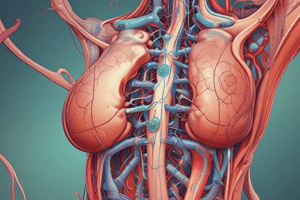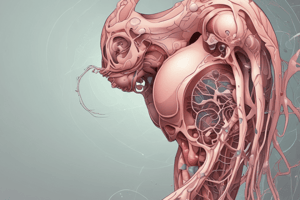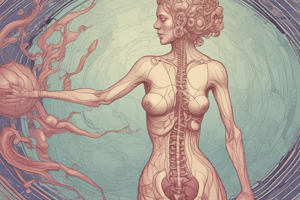Podcast
Questions and Answers
A client reports shoulder pain following a laparoscopy. What is the MOST likely cause of this pain?
A client reports shoulder pain following a laparoscopy. What is the MOST likely cause of this pain?
- An allergic reaction to the anesthesia used during the procedure.
- Post-operative bleeding irritating the phrenic nerve.
- Referred pain from the carbon dioxide used to distend the abdominal cavity. (correct)
- Musculoskeletal strain from being in a lithotomy position.
A nurse is providing education to a client scheduled for a colposcopy. Which instruction should the nurse emphasize to ensure the test's accuracy?
A nurse is providing education to a client scheduled for a colposcopy. Which instruction should the nurse emphasize to ensure the test's accuracy?
- Administer a Fleet enema the night before the procedure.
- Schedule the procedure during menstruation to improve tissue visibility.
- Refrain from consuming any food or liquids for at least 8 hours prior to the procedure.
- Avoid douching or sexual intercourse for 24 hours before the test. (correct)
Which assessment finding would be MOST concerning for a nurse caring for a client post-culdoscopy?
Which assessment finding would be MOST concerning for a nurse caring for a client post-culdoscopy?
- Difficulty urinating after the procedure.
- Slight serosanguinous drainage from the vaginal incision.
- An elevated temperature of 101.5°F and increased heart rate. (correct)
- Complaint of mild abdominal cramping.
A woman who has gone through menopause is curious about hormone replacement therapy (HRT). Which of the following should the nurse include in the discussion regarding the risks of HRT?
A woman who has gone through menopause is curious about hormone replacement therapy (HRT). Which of the following should the nurse include in the discussion regarding the risks of HRT?
A client presents with menorrhagia. What specific criteria defines this condition?
A client presents with menorrhagia. What specific criteria defines this condition?
A woman reports painful menstrual periods that have worsened over time. She is 35 years old and has a history of pelvic inflammatory disease (PID). What type of dysmenorrhea is she MOST likely experiencing?
A woman reports painful menstrual periods that have worsened over time. She is 35 years old and has a history of pelvic inflammatory disease (PID). What type of dysmenorrhea is she MOST likely experiencing?
A client is scheduled for a tubal insufflation (Ruben's test). What finding during the procedure would indicate that the fallopian tubes are PATENT?
A client is scheduled for a tubal insufflation (Ruben's test). What finding during the procedure would indicate that the fallopian tubes are PATENT?
A nurse is reviewing the results of a client's serum CA-125 test. An elevated level is noted. While this finding is associated with ovarian cancer, what OTHER conditions could also cause an elevated CA-125 level?
A nurse is reviewing the results of a client's serum CA-125 test. An elevated level is noted. While this finding is associated with ovarian cancer, what OTHER conditions could also cause an elevated CA-125 level?
A male patient is scheduled for a prostatic smear. What is the nurse's role in this diagnostic procedure?
A male patient is scheduled for a prostatic smear. What is the nurse's role in this diagnostic procedure?
A 17-year-old female has not yet experienced menarche. What is the term for this condition, and what are the POTENTIAL underlying causes?
A 17-year-old female has not yet experienced menarche. What is the term for this condition, and what are the POTENTIAL underlying causes?
A post-menopausal woman reports vaginal dryness and painful intercourse (dyspareunia). Which intervention is MOST appropriate to recommend?
A post-menopausal woman reports vaginal dryness and painful intercourse (dyspareunia). Which intervention is MOST appropriate to recommend?
What instructions should a nurse provide to a male patient after a testicular biopsy to promote healing and minimize discomfort?
What instructions should a nurse provide to a male patient after a testicular biopsy to promote healing and minimize discomfort?
Which diagnostic test involves the removal of a cone-shaped section of tissue from the cervix?
Which diagnostic test involves the removal of a cone-shaped section of tissue from the cervix?
A client is scheduled for a mammogram. What pre-procedure teaching should the nurse provide?
A client is scheduled for a mammogram. What pre-procedure teaching should the nurse provide?
What is the MOST appropriate initial intervention for a client experiencing premenstrual syndrome (PMS) with mild symptoms?
What is the MOST appropriate initial intervention for a client experiencing premenstrual syndrome (PMS) with mild symptoms?
A nurse is caring for a client who had a D&C. What instruction is MOST important for the nurse to provide to the client prior to discharge?
A nurse is caring for a client who had a D&C. What instruction is MOST important for the nurse to provide to the client prior to discharge?
A client is diagnosed with Metrorrhagia. How is this condition defined?
A client is diagnosed with Metrorrhagia. How is this condition defined?
During semen analysis, what factors are being evaluated?
During semen analysis, what factors are being evaluated?
What is the primary purpose of using a cystoscope in male clients?
What is the primary purpose of using a cystoscope in male clients?
Besides cancer, what condition is indicated by elevated levels of Prostate-Specific Antigen (PSA)?
Besides cancer, what condition is indicated by elevated levels of Prostate-Specific Antigen (PSA)?
A patient undergoing a culdoscopy reports increased abdominal pain and a low-grade fever 24 hours post-procedure. Which complication is MOST likely?
A patient undergoing a culdoscopy reports increased abdominal pain and a low-grade fever 24 hours post-procedure. Which complication is MOST likely?
A 45-year-old client presents with heavy, prolonged menstrual bleeding that has been occurring for the past six months. An endometrial biopsy reveals a benign tumor. What is the MOST likely diagnosis?
A 45-year-old client presents with heavy, prolonged menstrual bleeding that has been occurring for the past six months. An endometrial biopsy reveals a benign tumor. What is the MOST likely diagnosis?
A 55-year-old woman reports experiencing hot flashes, night sweats, and vaginal dryness. Her last menstrual period was 13 months ago. Which stage of life is MOST likely?
A 55-year-old woman reports experiencing hot flashes, night sweats, and vaginal dryness. Her last menstrual period was 13 months ago. Which stage of life is MOST likely?
A 28-year-old client reports experiencing severe mood swings, irritability, and bloating during the week before her menstrual period. These symptoms significantly impact her daily life. Which condition is MOST likely?
A 28-year-old client reports experiencing severe mood swings, irritability, and bloating during the week before her menstrual period. These symptoms significantly impact her daily life. Which condition is MOST likely?
A 30-year-old client who is not pregnant reports that her menstrual periods have stopped for the past seven months. She is not breastfeeding. Which condition is MOST likely?
A 30-year-old client who is not pregnant reports that her menstrual periods have stopped for the past seven months. She is not breastfeeding. Which condition is MOST likely?
A 22-year-old client reports painful menstruation that began after she was diagnosed with pelvic inflammatory disease (PID). Which of the following is the MOST likely diagnosis?
A 22-year-old client reports painful menstruation that began after she was diagnosed with pelvic inflammatory disease (PID). Which of the following is the MOST likely diagnosis?
Following a dilation and curettage (D&C) procedure, a client reports a fever of 101.5°F (38.6°C) and a foul-smelling vaginal discharge. What is the priority nursing intervention?
Following a dilation and curettage (D&C) procedure, a client reports a fever of 101.5°F (38.6°C) and a foul-smelling vaginal discharge. What is the priority nursing intervention?
A male patient reports burning and increased frequency after a cystoscopy. What intervention should the nurse suggest?
A male patient reports burning and increased frequency after a cystoscopy. What intervention should the nurse suggest?
A post-menopausal client asks about the benefits of hormone replacement therapy (HRT). What potential benefit should the nurse include in the response?
A post-menopausal client asks about the benefits of hormone replacement therapy (HRT). What potential benefit should the nurse include in the response?
During a tubal insufflation (Rubin's test), the client reports shoulder pain. What does this finding suggest?
During a tubal insufflation (Rubin's test), the client reports shoulder pain. What does this finding suggest?
A 16-year-old patient has not experienced menarche; what potential factor could be the cause?
A 16-year-old patient has not experienced menarche; what potential factor could be the cause?
A nurse is providing education regarding mammography screening guidelines to a group of women. Which recommendation is MOST accurate according to current guidelines?
A nurse is providing education regarding mammography screening guidelines to a group of women. Which recommendation is MOST accurate according to current guidelines?
A male client is scheduled for a prostatic smear. What is the purpose of this diagnostic test?
A male client is scheduled for a prostatic smear. What is the purpose of this diagnostic test?
A nurse is providing instructions to a client scheduled for a colposcopy. Which of the following instructions is MOST important for the nurse to include?
A nurse is providing instructions to a client scheduled for a colposcopy. Which of the following instructions is MOST important for the nurse to include?
After a testicular biopsy, which of the following self-care instructions is MOST appropriate for the nurse to provide?
After a testicular biopsy, which of the following self-care instructions is MOST appropriate for the nurse to provide?
Flashcards
Colposcopy
Colposcopy
Visual examination of the cervix and vagina using a specialized scope.
Culdoscopy
Culdoscopy
Direct visualization of the uterus, ovaries, and fallopian tubes through the posterior vaginal wall.
Laparoscopy
Laparoscopy
Visualization of the uterus, ovaries, and fallopian tubes through the abdominal cavity.
Biopsy
Biopsy
Signup and view all the flashcards
Conization
Conization
Signup and view all the flashcards
Dilation and Curettage (D&C)
Dilation and Curettage (D&C)
Signup and view all the flashcards
Mammography
Mammography
Signup and view all the flashcards
Pelvic Ultrasound
Pelvic Ultrasound
Signup and view all the flashcards
Tubal Insufflation
Tubal Insufflation
Signup and view all the flashcards
Testicular Biopsy
Testicular Biopsy
Signup and view all the flashcards
Semen Analysis
Semen Analysis
Signup and view all the flashcards
Cystoscope
Cystoscope
Signup and view all the flashcards
Prostate-Specific Antigen (PSA)
Prostate-Specific Antigen (PSA)
Signup and view all the flashcards
Primary Amenorrhea
Primary Amenorrhea
Signup and view all the flashcards
Secondary Amenorrhea
Secondary Amenorrhea
Signup and view all the flashcards
Primary Dysmenorrhea
Primary Dysmenorrhea
Signup and view all the flashcards
Secondary Dysmenorrhea
Secondary Dysmenorrhea
Signup and view all the flashcards
Menorrhagia
Menorrhagia
Signup and view all the flashcards
Metrorrhagia
Metrorrhagia
Signup and view all the flashcards
Menopause
Menopause
Signup and view all the flashcards
Cultures and Smears
Cultures and Smears
Signup and view all the flashcards
Pregnancy test
Pregnancy test
Signup and view all the flashcards
Serum CA-125
Serum CA-125
Signup and view all the flashcards
Prostatic Smears
Prostatic Smears
Signup and view all the flashcards
Premenstrual Syndrome (PMS)
Premenstrual Syndrome (PMS)
Signup and view all the flashcards
Premenstrual Dysphoric Disorder (PMDD)
Premenstrual Dysphoric Disorder (PMDD)
Signup and view all the flashcards
HRT
HRT
Signup and view all the flashcards
Transvaginal Ultrasound
Transvaginal Ultrasound
Signup and view all the flashcards
Study Notes
Diagnostic Testing for Females
- Colposcopy involves direct visualization of the cervix and vagina using a scope.
- A vaginal speculum is inserted, followed by a colposcope, which is a microscope to visualize the vaginal walls and cervix.
- Walls of the vagina may be swabbed with iodine or vinegar to remove surface mucus for better visualization.
- Observed factors include tissue color, presence of growths or lesions, and condition of vascularity.
- Specimens can be collected during a colposcopy.
- Should not be performed during menstruation.
- Clients should avoid bowel movements prior to the test if possible.
- Douching or sexual intercourse should be avoided for 24 hours before the test to prevent masking issues.
- Culdoscopy involves direct visualization of the uterus, ovaries, and fallopian tubes.
- Culdoscopy can be performed using local, spinal, or general anesthesia.
- The patient is placed in the knee-chest position during the procedure.
- The culdoscope is passed through the posterior vaginal wall.
- Culdoscopy can detect tumors, cysts, and endometriosis.
- Post-test, assess for bleeding and check vital signs.
- Ensure the patient can urinate after the test.
- Conization, the removal of eroded or infected tissue, can be performed during culdoscopy.
- Laparoscopy involves visualizing the uterus, ovaries, and fallopian tubes through the abdominal cavity.
- Tubal ligation can be performed during a laparoscopy.
- A urinary catheter is required during the procedure to decompress the bladder.
- Carbon dioxide is introduced into the abdominal cavity to distend it and improve structure visibility.
- General anesthesia is used for laparoscopy.
- Laparoscopy can detect masses, ectopic pregnancies, adhesions, and pelvic inflammatory disease.
- Patients may report shoulder pain due to the carbon dioxide gas after the test.
- Biopsies can be performed during laparoscopy to obtain tissue samples.
Biopsies and Conization
- Biopsies involve taking tissue samples for evaluation to confirm or locate a lesion.
- Reproductive biopsies include breast, cervical, and endometrial biopsies.
- Types of biopsies include fine needle aspiration, stereotactic or ultrasound-guided needle biopsy, and surgical biopsy.
- Conization is the removal of eroded or infected tissue to confirm cervical cancer.
- A cone-shaped section of tissue is removed from the cervix during conization.
- Conization is commonly performed after an abnormal Pap smear to investigate further.
- The area is packed with gauze after the procedure to decrease bleeding.
- Dilation and curettage (D&C) involves dilating the cervix and scraping material from the uterine wall.
- D&C can be done to remove tumors or abnormal tissue for biopsy.
- General anesthesia may be used for a D&C.
- Monitor for bleeding and foul odor following the procedure.
Smears and Mammography
- Cultures and smears are collected to examine and identify infectious processes, abnormal cells, or hormonal changes.
- Pap smears involve collecting scrapings from the cervix, placing them on a slide with a drop of water, and covering with a slide for microscopic examination.
- Mammography is a radiograph of breast soft tissue used to identify benign or cancerous processes.
- Digital mammography provides more detail.
- Annual mammograms are recommended from ages 40 to 54, and every other year after 54.
- Tumors are usually present for nine years before palpation is possible.
- No body powders, deodorant, or ointments should be used on the breast before mammography to avoid false positives.
Ultrasounds, Pregnancy Tests, and CA-125
- Pelvic ultrasounds detect foreign bodies and differentiate between cysts and solid tumors and evaluate fetal growth and viability.
- A pregnancy test detects human chorionic gonadotropin (HCG).
- Serum CA-125 is a tumor antigen associated with ovarian cancer.
- Elevated CA-125 levels can also be caused by endometriosis, pelvic inflammatory disease, pregnancy, gynecological cancers, and pancreatic cancer.
- Transvaginal ultrasounds use a wand inserted into the vagina for closer visualization of pelvic structures.
Tubal Insufflation
- Tubal insufflation (Rubin's test) assesses the patency of the fallopian tubes.
- Carbon dioxide is introduced into the tubes to check if they are open.
- If the tubes are open, gas will pass into the abdomen, producing a high-pitched bubbling sound detectable with a stethoscope.
- Shoulder pain may occur due to the gas.
- The test typically takes 30 minutes and is performed on an outpatient basis.
- If the tubes are closed, gas cannot pass through, and the patient will report no pain.
Diagnostic Testing for Males
- Testicular biopsy detects abnormal cells or the presence of sperm.
- A testicular biopsy can be performed through aspiration or incision, depending on the anesthesia used.
- Scrotal support, such as snug underwear, is recommended after the biopsy.
- Ice packs reduce swelling, and over-the-counter analgesics and warm sitz baths can provide relief.
- Patients should report any fever or bleeding immediately.
- Semen analysis evaluates fertility, post-vasectomy effectiveness, evidence in rape cases, and paternity.
- Prostatic smears identify microorganisms, tumor cells, or tuberculosis cells of the prostate.
- A provider massages the prostate via the rectum, and the patient voids into a sterile container.
- Cystoscopy involves using a scope to examine the prostate and bladder through the urethra.
- Cystoscopy can detect bladder infections and tumors.
- Patients may experience pink-tinged urine, increased frequency, and burning after the test.
- Warm sitz baths or analgesic medications can help with post-procedure discomfort.
- Prostate-specific antigen (PSA) is found in the bloodstream in cases of cancer and benign prostatic hypertrophy.
- A PSA level of less than four is considered normal; elevated levels require monitoring and possibly biopsy.
Amenorrhea
- Amenorrhea is the absence of menstrual flow.
- Primary amenorrhea is when menarche has not occurred by age 17 or 18, typically due to hormone imbalance, genetics, or structural issues.
- Secondary amenorrhea is when flow has ceased for six months in someone who has previously menstruated.
- Pregnancy, breastfeeding, and menopause are excluded from this definition.
- Causes include frequent vigorous exercise, emotional disorders, low body fat, contraceptives, pituitary tumors, hyperactive thyroid, and polycystic ovarian syndrome.
- Treatment involves addressing the underlying cause, possibly with hormone therapy.
- The first step is to confirm the person is not pregnant before further investigation.
Dysmenorrhea
- Dysmenorrhea is painful menstruation/menstrual cramps.
- Primary dysmenorrhea is not associated with pelvic disorders.
- Secondary dysmenorrhea is caused by diseases like PID, endometriosis, STIs, or fibroid tumors.
- Primary dysmenorrhea often improves after pregnancy or in the 30s.
- Secondary dysmenorrhea is typically found in people greater than 20 years of age.
- Pain usually starts 24-48 hours before menses or with onset.
- Diet high in complex carbohydrates and fiber with limited caffeine, sugar, and alcohol is recommended.
- Otherwise, manageable with heat and over-the-counter analgesics (Advil, Tylenol).
- Medications like Celebrex and Aleve can also help.
- Vitamins, oral contraceptives, physical activity, and sexual intercourse may provide relief.
- Treat the underlying cause if secondary to another disorder.
Abnormal Uterine Bleeding
- Menorrhagia is excessive bleeding during regular menstrual flow.
- It may involve an increase in duration greater than seven days or an increased amount of blood that is greater than 80 mL.
- Metrorrhagia is bleeding between regular menstrual periods.
- In postmenopausal women, metrorrhagia may indicate cancer or a benign tumor of the uterus.
- Endometrial biopsy and D&C may be used to diagnose the cause.
- Assess the bleeding, pain, and have the client keep a diary of bleeding characteristics.
Premenstrual Syndrome (PMS)
- PMS occurs due to hormonal changes during the menstrual cycle.
- Risk factors include being female, being 25-40 years of age, increasing symptoms near menopause, diet high in sugar, personal/family history of depression, or history of postpartum depression.
- Symptoms begin 5-10 days before the menstrual period and subside 1-2 days after onset.
- 90% of women have PMS.
- Premenstrual dysphoric disorder (PMDD) as PMS symptoms with severe mood disorders.
- PMDD involves an excessive response to hormonal changes.
- Depression, hopelessness, anger, anxiety, or tension.
Clinical Manifestations and Treatment of PMS/PMDD
- Irritability, lethargy, fatigue, sleep disturbances, depression, headache, anxiety, mood swings, vertigo, backaches, breast tenderness, bloating, acne, paresthesias, difficulty concentrating, forgetfulness, and worsened allergies.
- Treatment involves addressing specific symptoms.
- Analgesics, diuretics, and oral contraceptives.
- Antidepressants may be prescribed.
- Cessation of smoking and alcohol, dietary changes (small frequent meals, limiting sugar/sodium/caffeine, whole grains and fiber), exercise, stress reduction (yoga or meditation), and adequate sleep.
Menopause
- Menopause (climacteric) is a phase of aging transitioning from reproductive to non-reproductive.
- Normal cessation of menstruation.
- Perimenopause can last up to four years with infrequent/abnormal periods and possible conception.
- Average age is 42-58 with an average of 51.
- Menopause is complete after one full year without a period.
- Hormonal menopause decreases hormone levels in middle adulthood.
- Surgical menopause is loss of hormone production after surgery (bilateral salpingo-oophorectomy).
- Pharmacological menopause can be induced by medications like Lupron that decrease estrogen and progesterone.
- Increased risk of cardiovascular disease, thinning hair, bone loss, dry/rough skin, drooping breasts, smaller nipples, loosening teeth, receding gums, and urinary incontinence.
Signs, Symptoms, and Post-Menopause considerations
- Headaches, hot flashes, fatigue, vertigo, nausea, diaphoresis, weight gain, vomiting, palpitations, chest/neck pain, dyspareunia, and tachycardia.
- After menopause, estrogen-affected body parts change.
- Shrinking of vulval/perineal/genital structures, atrophic vaginitis, shortening of vagina, dry vaginal walls.
- KY Jelly or lubricant can help with sex.
- Relaxation of pelvic structures, urinary frequency, cystitis, and urgency.
- Decreased breast tissue and increased subcutaneous fat.
Treatment for Menopause
- Hormone replacement therapy (HRT) can help with moderate to severe symptoms.
- Use the lowest effective dose for the shortest duration.
- Vitamin D and calcium supplements, decreasing caffeine and alcohol, and increasing air circulation, using light covers, wearing loose clothing, and using cool cloths.
- Exercise programs with weight bearing decrease the risk of osteoporosis.
- Nutritious diet and weight control, breast self-exams, watching calcium intake, contraceptive use for one year after the last menstrual period, and performing Kegel exercises.
- Teach side effects of medications and encourage the patient to have annual physical exams.
- Kegel exercises strengthen pelvic structures.
- Patient needs to squeeze muscles down there, hold for 10 seconds, and relax; repeat 20-40 times a day.
Studying That Suits You
Use AI to generate personalized quizzes and flashcards to suit your learning preferences.




